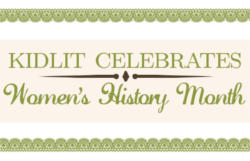March 13 - Today's post provided by Audrey Vernick
Something That Is Meaningful: Telling Effa Manley’s Story
I have a college-aged nephew and a teenaged niece, siblings, who are notorious for being terrible storytellers. They famously backtrack in the midst of every story they tell to fill in details, some of which matter: “Wait, did I mention we were at a zoo?”
That same issue—context—is always my greatest concern when writing nonfiction for children. It requires a precise touch; you can’t condescend, but you have to be mindful of the fact that young readers often lack the historical understanding required to fully appreciate a given narrative.
When I discovered Effa Manley’s story in 2006 and shared it, with great excitement, with the baseball- and book-loving people I know, adults, they understood its appeal immediately. A woman in baseball? In the 1930s and ‘40s? An African-American woman?
As much as kids know that ours was a largely segregated country at that time, it’s really hard to adequately drive that point home in a way that effectively conveys the humiliation, the daily indignities so many people endured. It has become a fact memorized: separate entrances, separate water fountains, back of the bus. Likewise, I don’t think most kids really understand how limited employment opportunities were for women in Effa Manley’s day.
If I had a chance to sit down with my readers, I’d end up telling Effa Manley’s story just like my niece and nephew tell their stories, circling back repeatedly to fill in spots that might be blanks.
With any book, but especially with a picture book, you have to use your words wisely. Representing a life in a mere 32 pages (with big illustrations on each page) requires you to make difficult choices. You can’t afford to spare any words to drop out of your story to say, Now listen up and pay attention, here, reader. Women just didn’t do that kind of thing in those days!
As with any piece of writing, you do the best you can. You use words to provide a framework for understanding, and you hope for the best.
Sometimes you count on a co-reader—parent, teacher, librarian—to play the role of my niece and nephew. A reader can step outside a story in a way a writer can’t. They can spiral back around and fill in the blanks.
When I think of what ended up on the SHE LOVED BASEBALL cutting room floor -- the anecdotes, the contextual clues, the telling moments -- I try to remind myself, to make myself sincerely believe, that it’s not necessary for a child to understand every aspect of the story in all the exact ways I intended. What’s important is that readers take away something that is meaningful.
There’s also the delicious knowledge that readers can return to a book with a year or two of life under their belt, with a greater understanding of the world, and comprehend the book in a newer, deeper way. I loved that sense of getting it more, getting it better, each time I read a book as a child. I still do.
Taking the long view, we really shouldn’t lose sight of this: a young reader’s possible inability to understand how rare it was for a woman to be so influential and powerful at that time in our history is really, at its core, a fantastic indicator of all the progress we’ve made.
Effa Manley inspired me in the way she always stood up for what was right and did what needed to be done, without any regard for what others might think. That is the meaningful something I hope all readers will get. No circling back around required.
Editors Note: Find out more about Audrey Vernick at her website or visit her blog, She Loved Baseball: An Author's Thoughts from Left Field.
A discussion guide for teachers for She Loved Baseball is also available at her website.













I'm a fellow New Jerseyan so some my say that I'm biased, but this book looks sensational! I'll definitely add it to my line-up of baseball books for this spring. Readers of this blog should go and check out the book trailer at Audrey's site, and also the teaching guide she's provided at http://www.audreyvernick.com/SheLovedBaseballGuide.pdf. Either one of those will encourage you to learn more about Effa Manley.
ReplyDeleteAnother fellow New Jerseyan chiming in - I wish I had known the story of Effa Manley before visiting the Baseball Hall of Fame; I would have looked for her plaque. I guess I'll just have to go back! I envy you the time you spent in their archives. I was positively drooling when I passed by the door that said "Hall of Fame Librarian." What a dream job! Wonderful book, wonderful post, and I love your blog, too - She Loved Baseball: An Author's Thoughts from Left Field.
ReplyDelete